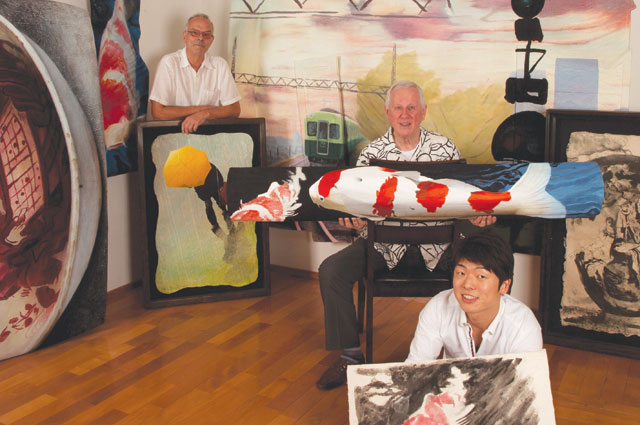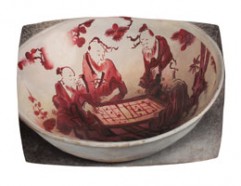In the art world, it’s not unusual to hear about famous pieces selling for seemingly astronomical prices.
Whether it’s Jackson Pollock’s No. 5, 1948 selling for $140 million in 2011, or this year’s sale of Picasso’s Le Rêve for $155 million, the prices seem unbelievable, but they fit into one conception of the meaning of art: art as investment. On the other hand, there are some of us who look at the subject differently: we enjoy art, but we don’t know exactly where to begin a collection. The prospect of buying something with an eye to eventually sell it later can seem intimidating.
The Weekender sat down with Norman Tolman, one of the prominent figures in the world of contemporary Japanese prints, to talk about the art world, a career’s worth of collecting prints and paintings, and his October collaboration with Daniel Kelly.
The Path to Art Collecting
Hailing from Boston, Tolman first came to Japan with the US Air Force in 1955. Having studied Japanese already at Yale, his early experiences kindled an interest in Asian culture in general and Japanese prints in particular. After the Air Force, college at UC Berkeley and an MA from Yale, he returned to Japan on a Fulbright scholarship to the Inter-University Center for Japanese Language Studies and Tokyo University, where he studied Japanese research on late Tibetan and early Chinese linguistics. After realizing, as he
“Art is basically not a group thing: everyone has his own taste, his own likes and dislikes. With prints the choices are seemingly unlimited . . .”
explained, “that there weren’t going to be that many people interested in a conversation on late Tibetan and early Chinese,” he shifted away from the ivory tower of academia and into the field of diplomacy. A career in foreign service sent him to Hong Kong, Tokyo, Sapporo, and Kyoto, and gave him the opportunity to begin collecting Japanese prints. The decades after World War II were an excellent time to collect prints, and they still remain a lower-cost art investment for younger buyers on a budget. Tolman began to amass a considerable collection, and as his passion for print collecting and appreciation grew, he realized that collecting meant more to him than his day job. He decided to take a risk and go into art dealing full time.
Starting out on this new venture initially meant that Tolman had to work several different jobs until he could sustain as an art dealer. As a judge for the annual art exhibition of the College Women’s Association of Japan (CWAJ), he worked with the famous writer James Michener, who was a major figure in introducing Japanese art to the American public. He also wrote a weekly column for the Mainichi Daily News, a job that found him writing a profile on the artist Toko Shinoda; this article was the very first step in a business relationship—he is her main dealer, and has been for more than half his life.
Galleries around Town, and around the Globe
Tolman opened his first gallery in a large, traditional Japanese house in Suginami-ku, which was open for private showings and appointments. After some time, the collection moved to the charming atmosphere of what used to be a geisha’s house in Minato-ku’s Shiba Daimon. A private gallery in nearby Atago jinja mae has recently been added. As its presence in the global art world has grown, the Tolman Collection has expanded to Hong Kong, which maintains a gallery of both Japanese and Chinese art, and to a New York gallery run by a second generation Tolman in the art world, daughter Allison. The Collection has also had galleries in Singapore and Shanghai, and a location in London is opening in November.
Collecting Paintings and Prints: Who does it, and where do you start?
Although most people buy for their own pleasure, prints can be a smart investment for art lovers, especially younger ones, because of the wide variety of pieces available. Tolman explains that one of the rewards from his work as a dealer is the enjoyment he gets from it, and the broad range of the collectors he works with. “Art is basically not a group thing: everyone has his own taste, his own likes and dislikes. With prints the choices are seemingly unlimited and it is fun to be able to show what kind of a person one is by one’s collection.” The collectors he works with have a range of interests that vary from
the work of a single artist, to one specific color, to a particular subject. Others try to collect broadly, in an attempt to cover all of the bases. Some make a narrative with their pieces, creating a collection that tells the story of the life they have spent in Japan.
In the case of paintings, particularly some of the larger ones by Daniel Kelly that were shown at his retrospective, the scale and price of these works place them in the range of more serious, experienced collectors. But works like these are not to be thought of as expensive investments, they can become part of a family’s legacy, or a powerful statement of a collector’s personal and aesthetic philosophy.
The Daniel Kelly Art Extravaganza
Norman Tolman and Daniel Kelly go back a long way, and Tolman has nothing but admiration for his collaborator’s body of work: “He has a unique style and as he has gotten older, he has developed a very special work ethic, and is totally committed to his art. I have noticed this during the formation of this exhibition, which is truly unusual, since it encompasses everything he does, prints and paintings, both small ones and large masterpieces.” Another special element of the show was the camaraderie between the two, which allowed them to put together a show without the tensions that sometimes can arise between dealer and artist.
For more information about the Tolman Collection, Tokyo please visit their site.
Main image: From right to left, Daniel Kelly, Norman Tolman, and Tolman’s personal assistant, Shin Mochizuki










